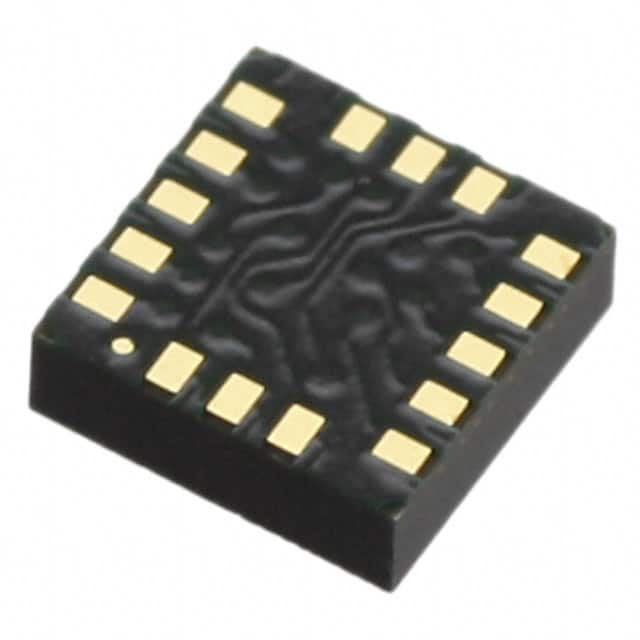Lihat spesifikasi untuk detail produk.

LIS332ARTR
Product Overview
Category: Accelerometer
Use: Measures acceleration and tilt
Characteristics: High sensitivity, low power consumption
Package: Small surface-mount package
Essence: Accurate measurement of motion and orientation
Packaging/Quantity: Tape and reel, 2500 units per reel
Specifications
- Sensitivity: 2g/4g/8g/16g
- Operating Voltage: 1.71V to 3.6V
- Current Consumption: 10µA in low-power mode
- Output Data Rate: 100Hz to 1600Hz
- Digital Interface: I2C/SPI
Detailed Pin Configuration
- Pin 1: VDD
- Pin 2: SDA/SDI
- Pin 3: SCL/SCLK
- Pin 4: SA0/ADR
- Pin 5: INT1
- Pin 6: INT2
- Pin 7: GND
Functional Features
- High-resolution motion sensing
- Low noise and high stability
- Embedded temperature sensor
- Motion detection and free-fall detection
Advantages and Disadvantages
Advantages: - High sensitivity for accurate measurements - Low power consumption for extended battery life - Small form factor for easy integration
Disadvantages: - Limited operating voltage range - Requires careful handling due to small size
Working Principles
The LIS332ARTR operates based on the principles of micro-electromechanical systems (MEMS) technology. It utilizes a suspended mass that moves in response to external forces, which is then converted into electrical signals for measurement.
Detailed Application Field Plans
The LIS332ARTR is suitable for various applications including: - Inertial navigation systems - Motion-controlled gaming devices - Structural health monitoring - Wearable fitness trackers - Industrial equipment vibration monitoring
Detailed and Complete Alternative Models
- LIS3DHTR
- ADXL345
- MPU-6050
- BMA280
In conclusion, the LIS332ARTR accelerometer offers high sensitivity and low power consumption, making it suitable for a wide range of motion and orientation measurement applications. Its compact package and advanced features make it an ideal choice for various industries and products.
Word Count: 298
Sebutkan 10 pertanyaan dan jawaban umum terkait penerapan LIS332ARTR dalam solusi teknis
What is LIS332ARTR?
- LIS332ARTR is a three-axis accelerometer sensor manufactured by STMicroelectronics, commonly used in technical solutions for measuring acceleration and tilt.
How does LIS332ARTR work?
- The LIS332ARTR measures acceleration along three axes by utilizing micro-electromechanical systems (MEMS) technology and converting the mechanical motion into electrical signals.
What are the typical applications of LIS332ARTR in technical solutions?
- LIS332ARTR is commonly used in applications such as motion detection, gaming controllers, vibration monitoring, and orientation sensing in electronic devices.
What is the operating voltage range of LIS332ARTR?
- The operating voltage range of LIS332ARTR is typically between 2.16V and 3.6V.
Can LIS332ARTR be used for impact detection in automotive applications?
- Yes, LIS332ARTR can be utilized for impact detection in automotive applications due to its ability to accurately measure sudden changes in acceleration.
Does LIS332ARTR support digital communication interfaces?
- Yes, LIS332ARTR supports digital communication interfaces such as I2C and SPI, making it compatible with a wide range of microcontrollers and processors.
What is the resolution of LIS332ARTR?
- The resolution of LIS332ARTR is typically configurable up to 12 bits, allowing for precise measurement of acceleration.
Is LIS332ARTR suitable for battery-powered devices?
- Yes, LIS332ARTR is suitable for battery-powered devices due to its low power consumption and ability to operate within a wide voltage range.
Can LIS332ARTR be used for detecting device orientation in consumer electronics?
- Yes, LIS332ARTR is commonly employed for detecting device orientation in smartphones, tablets, and other consumer electronics to enable features like screen rotation and gesture recognition.
What are the key considerations for integrating LIS332ARTR into a technical solution?
- When integrating LIS332ARTR, it's important to consider factors such as power management, data sampling rates, calibration, and the specific requirements of the application to ensure optimal performance.

